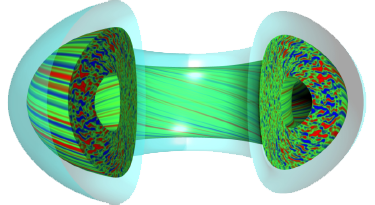Permutation entropy (PE) is an information-theoretic complexity measure; it is a single number that represents the information rate to derive the ordinal properties of a time series. In sliding window analysis of a single information channel, a change of PE can indicate a bifurcation of the system state. The method is robust and fast. Therefore, the PE approach is applied on large data sets of...
Reduced models of SOLPS-ITER plasma edge simulations are deployed in the time-dependent model predictive control of upstream and downstream divertor conditions. Virtual main ion and impurity gas puffs actuate the simulated tokamak boundary based on predictions obtained from the dynamic mode decomposition (DMD) and the Sparse Identification of Nonlinear Dynamics (SINDy) data-driven techniques....
Gaussian Process Regression (GPR) is a Bayesian method for inferring profiles based on input data. The technique is increasing in popularity in the fusion community due to its many advantages over traditional fitting techniques including intrinsic uncertainty quantification and robustness to over-fitting. Most fusion researchers to date have utilized a different GPR kernel for each tokamak...
Digital twins capable of predicting plasma evolution ahead of plasma progression within a Tokamak is a crucial tool required for real-time plasma intervention and control. Considering speed and scale required, quite often these have to be purely data conditioned models as opposed to being physics conditioned, making data selection a vital component of model efficacy. However, as we move to the...
Tractable and accurate prediction of tokamak plasma temperature, density and rotation profiles is vital for interpretation and preparation of current-day fusion experiments, optimization of plasma scenarios, and designing future devices. Predictions can be made using so-called integrated modelling suites, a collection of codes describing different physical processes integrated together to...
Gyrokinetic codes are the essential tools to predict and understand turbulent transport in magnetically confined fusion plasmas. They calculate the time evolution of the perturbed distribution function in the five-dimensional phase space. It often takes more than a few days to finish their runs and an enormous amount of calculation data is generated per run. When such codes are used to...
UTILISING CLOUD RESOURCES TO PERFORM MONTE-CARLO BASED UNCERTAINTY QUANTIFICATION OF FUSION SIMULATIONS
Stanislas Pamela
UKAEA
Abingdon, UK
Email: Stanislas.Pamela@UKAEA.uk
James Buchanan
UKAEA
Abingdon, UK
Email: James.Buchanan@UKAEA.uk
Andrew Lahiff
UKAEA
Abingdon, UK
Email. Andrew.Lahiff@UKAEA.uk
Abstract
The increased...
Controlling impurity ions is a critical requirement for a fusion reactor. Impurity accumulation in the core region dilutes fuel and radiates away power through line emission and enhanced Bremsstrahlung. However, a proper amount of impurity is likely to be required in the edge region in order to mitigate the heat load on the plasma facing components.
The transport properties of impurity ions...
Impurity and neutral particles play a critical role in tokamak core-edge integration. This motivates close examination of state-of-the-art transport models and comparison of their predictions with experiments using modern computational statistics tools. Here we present a High Performance Computing (HPC) framework for fully-Bayesian inferences of particle diffusion and convection profiles and...
Magnetic confinement fusion experiments generate large quantities of complex data. At a basic level, the data reflects the state of the machine and plasma, enabling a safe and reliable operation of the device, i.e. well within the design limits of the machine and compatible with the scientific goals of the experiment. Depending on the requirements, different analysis techniques are needed to...
ASTI, a data assimilation system for integrated simulation of fusion plasma, is being developed to analyze, predict, and control the fusion plasma behavior. ASTI employs the ensemble Kalman filter (EnKF) and smoother (EnKS) as data assimilation methods. The integrated transport simulation code for helical fusion plasmas, TASK3D, is employed as the system model in the data assimilation...
A novel approach using Bayesian inference has been implemented using the Bayesian Framework
Minerva to interpret the filamentary dynamics measured by a Langmuir probe fixed to a
reciprocating assembly on MAST. The model describes the system as a superposition of time-
displaced filaments and a fixed background component. Each filament is parameterised in terms
of a characteristic rise and...
Fluid based scrape-off layer transport codes such as UEDGE are heavily utilized in tokamak analysis and design, but typically require user-specified anomalous transport coefficients to match experiment. Determining uniqueness of these parameters and the uncertainties in them to match experiments can provide valuable insights to fusion scientists. We leverage recent work in the area of...
The well-known IPB98 scaling law for the energy confinement in tokamak H-mode plasmas has recently been revised. A considerably larger data set was used for estimating the scaling, including data from devices with fully metallic walls (JET and ASDEX Upgrade). In order to facilitate comparison with IPB98, the new scaling was estimated using a simple power-law model. Like its predecessor, the...
An example for complementarity between plasma physic and data-driven research will be reported. It is the application of the information criterion (either Akaike or Bayesian) in the field of the statistics to the data obtained in the fusion research. A particular example described in the paper is the trials being conducted by utilizing the thermal diffusivity database in the Large Helical...

